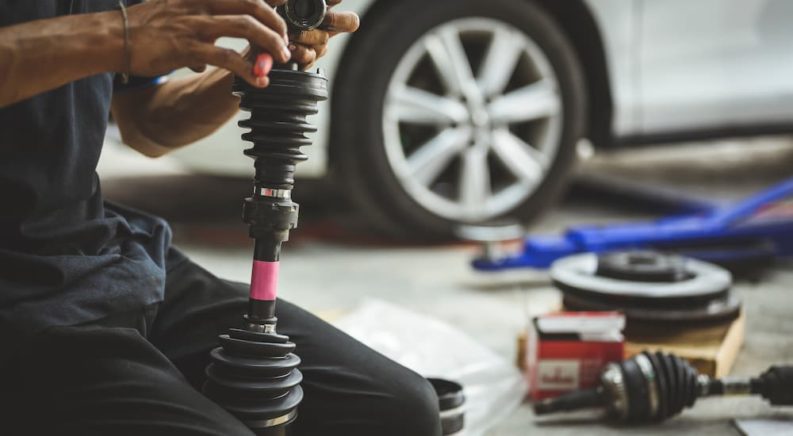Your vehicle’s driveshaft plays a vital role in transferring mechanical energy throughout your vehicle. The long, tubular component is usually made from steel, aluminum, or carbon fiber and is located underneath the vehicle. It allows torque to travel from the transmission to the front or rear differentials and then into the wheels themselves. It’s just one part of a vehicle’s drivetrain, which also includes the transmission, differential, axles, CV joints, and wheels.
Driveshafts can look very different, depending on what type of vehicle you’re dealing with. In fact, some vehicles don’t have a traditional driveshaft at all. The exact makeup of the driveshaft depends on whether the vehicle in question is front-, rear-, or all-wheel drive—but regardless of the setup, the principle remains the same: transmitting power from the engine to the wheels that need it. Let’s take a closer look at what exactly a driveshaft does, how it fits in with the rest of the drivetrain assembly, and some common signs of a failing driveshaft.
What Is a Driveshaft?
In rear-wheel drive and four-wheel drive vehicles, the driveshaft is a long rod that extends from the transmission to the rear differential, allowing the torque from the engine to deliver power to either the rear wheels or all four wheels, depending on the setup. A driveshaft is just one component of the greater driveshaft assembly, which also includes universal joints or u-joints, slip splines, and yokes. In addition to transferring power, a driveshaft has to be able to work at a variety of angles due to the bouncing and shifting that takes place when vehicles accelerate, decelerate, or turn. This is made possible by the u-joint, which can move freely and allow some play between the main driveshaft and differential. This is where the other components in the driveshaft assembly come in, allowing the driveshaft to operate at a variety of angles with no loss in power.
But what about front-wheel drive vehicles? When the wheels are located so close to the engine, a long driveshaft doesn’t really make much sense. Instead, front-wheel drive vehicles feature a transaxle that combines the transmission and axle into one handy component. The transaxle is then connected to the wheel by a smaller version of a driveshaft, called a half-shaft. Front-wheel drive vehicles with transaxles often have their engines oriented sideways in what’s known as transverse engine placement within the engine compartment; this makes it easier to transfer torque to the front wheels. Thanks to the absence of a traditional driveshaft, front-wheel drive vehicles can often be designed smaller and lighter than rear- or all-wheel drive vehicles.
The last piece of the drivetrain I’ll discuss in relation to the driveshaft is the differential. Located where the axle meets the driveshaft, the differential plays an important role in allowing the wheels to move at different speeds. This might seem like a less-than-desirable feature, but it’s actually a vital piece of the design. When a vehicle goes into a turn, the inside wheel—that is, the wheel closer to the direction of the turn—doesn’t need to cover as much distance as the outside wheel. The differential allows the outside wheel to keep pace by moving at a faster rate than the inside wheel, rather than skid along uselessly.

Signs of a Failing Driveshaft
So how do you know if your driveshaft isn’t in good shape? There are a few tell-tale signs that can make driveshaft-related issues fairly easy to diagnose. Just note that except in the case of excessive stress or corrosion, the driveshaft itself isn’t too prone to failure. So, any issue could be related to other drivetrain components (or something else altogether).
Vibrations
The most common symptom of a failing driveshaft is strong vibrations in the vehicle. The issue can usually be traced to a number of components that make up the driveshaft assembly, from U-joints or bushing that have worn out to the driveshaft itself not being properly bolted down. At first, it might be difficult to differentiate driveshaft-related vibrations from your vehicle’s baseline buzzing—but if it gets worse with time or sounds louder than normal, it’s time to bring it in for a check-up.
Shuddering While Accelerating
While “shuddering” might just seem like another way to say vibrating, it’s a far more noticeable phenomenon. This isn’t your garden-variety rumbling, but a far more noticeable sensation that reverberates throughout the vehicle. Shuddering can be felt throughout the vehicle and is usually more pronounced when accelerating. This usually indicates a loose u-joint or worn center bearing. This issue should be addressed immediately, as it can cause other parts of the drivetrain assembly to wear out prematurely.
Squeaking, Knocking, or Clicking Sounds
If you can’t tell your squeaks and knocks from your clunks and clicks, I don’t blame you, but training your ears to notice some of the more unusual sounds a vehicle makes can be very helpful when it comes to diagnosing issues. If your vehicle is exhibiting noticeable squeaks when in operation, it could be traced to failing bushing or bearings. It could also just indicate a drivetrain in dire need of a little TLC, so try lubing up the u-joint and other conspicuous components before getting too far ahead of yourself. Other noises, like knocking and clicking, could be traced to a failing CV joint.
Clunking Sound
If your vehicle makes a distinct clunking noise, especially when shifting, you could be looking at a worn-out u-joint. Given the amount of stress they’re under, u-joints are more prone to failure than some of the more solid components in the driveshaft assembly. Luckily, they’re also among the cheaper parts to replace.
Problems Turning
Given its role in directing power to the wheels, problems with turning can often be traced to driveshaft issues. A worn driveshaft won’t allow the wheel to turn properly, impacting your ability to safely control the vehicle. This can be a dangerous symptom, to say the least, and should be addressed without any delay.

Repair
Once you’ve narrowed down your issue to either the driveshaft itself or a particular component in the drivetrain assembly, it’s time to get to work. Some drivers might be surprised to learn that despite the vital role it plays in your vehicle’s operation, a driveshaft replacement isn’t actually the trickiest job under the sun. While the process varies between vehicles—depending on their design and whether they’re FWD, AWD, or 4WD—it only requires some basic hand tools, pry bars, and a willingness to get your hands dirty.
Replacement driveshafts typically cost anywhere between $400 and $1,000, so it’s not going to be a cheap fix. However, taking the D.I.Y. approach could save you a couple-hundred bucks in labor costs.
If you only need a section of the driveshaft replaced, the bill could go down to a range from $300 to $800. I won’t get into the specifics on driveshaft replacement here, but just find a vehicle-specific repair manual from Haynes or Chilton, or look up a few YouTube videos on the process. As you may have noticed in the section above, failing u-joints are some of the most common culprits when it comes to drivetrain assembly issues. Again, replacement isn’t a terribly difficult task, but it will require some patience. Those leaving it to the pros can expect to pay between $250 and $300 for u-joint replacement, including labor.
The driveshaft is an important element in any vehicle, but isn’t very well understood by many casual drivers. Hopefully, this primer has given you a better idea of the role a driveshaft plays in your vehicle, common signs of failing components, and a few helpful guidelines when it comes to repair and replacement costs.
While replacing a driveshaft or u-joint might not be the perfect starter task for the nascent DIY-er, it should be well within reach by the time you have a few smaller repair and maintenance jobs under your belt. Study up, start with projects where you’re confident, and with a little time and some practice, paying for repairs and labor could soon be a thing of the past.

